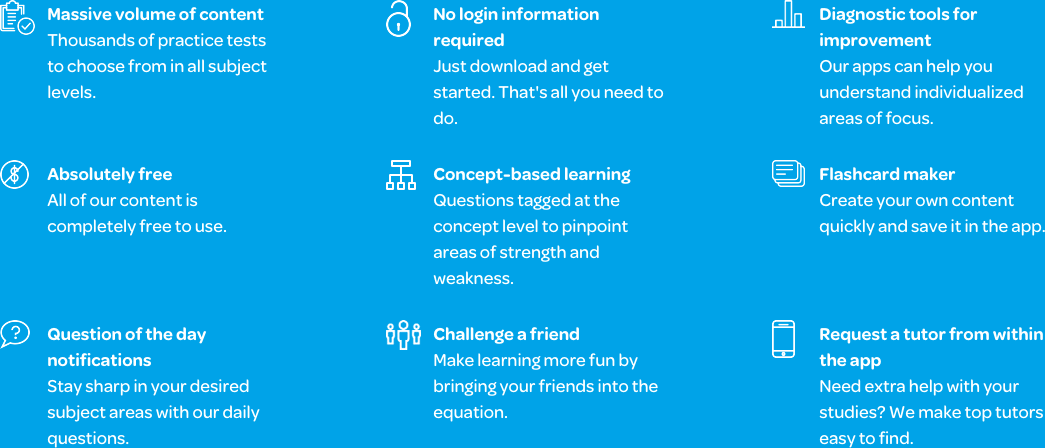The Varsity Tutors PSAT Mobile App
The PSAT is much more than a trial run for the SAT. It can be a prerequisite for certain scholarships, or it may help you gain the attention of your dream school early on in your educational career. It can also help you identify areas that you will need to work on for the SAT you will take in the future. The free Varsity Tutors PSAT Prep app for iPhone, iPad, and Android devices can assist you as you prepare for the PSAT, and can also help you learn test-taking skills you will eventually use on other standardized tests.
The PSAT has a very particular format, and the practice tests on the PSAT Prep app are created to mimic the test as closely as possible. Test-takers will spend 60 minutes on Critical Reading, 35 minutes on Writing and Language, and 70 minutes on Math. The Math section includes 25 minutes of problems to be solved without a calculator, and 45 minutes of problems on which you may use a calculator. The app can help you drill down into each of these topics, so you can get as specific in your studies as you like.
The PSAT begins with the Critical Reading section, which is focused on passage-based questions. You will need to know how to extrapolate ideas, understand organization and arguments, and explain the content of passages on the humanities, literary fiction, social science, and natural science. The app will also help you as you learn to successfully navigate the sentence completion portion of the Critical Reading section, which involves using context clues to complete one- and two-blank sentences.
Then, the PSAT Math section will test you on algebraic concepts, including algebraic fractions and functions, the distributive property, equations, inequalities, exponents, and more. There are also arithmetic questions covering skills like basic squaring and square roots, decimals, fractions, and percents. This is followed by problems involving data analysis and geometry.
Finally, in the PSAT Writing and Language section, you will encounter questions on identifying errors in sentences, punctuation, and word usage. You will also work on improving paragraphs and sentences by finding and correcting errors.
The PSAT Prep app has a variety of resources designed to challenge you. When you take one of the full-length, timed practice tests, you will get a good idea of which areas you need to focus your further studying on. You will also receive the answers to all of the questions on the practice test. The detailed explanations explain the correct answer, how it was reached, and the logic behind it.
Once you identify the specific topics on which you need more review, you can use the Learn by Concept resource and the flashcards to help you recall important facts, details, and concepts. You can even make your own flashcards with the Flashcard Maker that include your own images, audio clips, and text.
Be sure to download this must-have Varsity Tutors PSAT Prep app from iTunes or the Google Play Store today. It just may be the thing that makes all the difference in your PSAT score!
66 mobile apps to choose from for your tutoring needs.

Learn More
If you are a high school student who is a junior or sophomore, and you are interested in pursuing higher education after receiving your high school diploma, you may want to take the Preliminary SAT, otherwise known as the PSAT. It is a standardized test which is administered by the College Board and is similar in fashion to the SAT.
While the primary function of the PSAT is to prepare you for the SAT, it can also be taken to qualify you for the National Merit Scholarship Competition. This competition awards roughly 8,200 scholarships each year to students with the top marks. Additionally, the PSAT is a great way to help you gain important feedback on your test-taking abilities, as well as to prepare you for studying college-related material.
The PSAT consists of four separate sections: two math portions, a writing component, and a critical reading section. You are given two hours and ten minutes to finish the test. With the exception of the writing component, the test is multiple-choice, and you usually have four answers to choose from.
In order to properly prepare for the PSAT, you should spend time studying several areas. For example, in order to successfully complete the writing component of the exam, you should have a working knowledge of English grammar, as well as a diverse lexicon. This part of the test doesn’t actually require writing, but rather has you play the role of an editor. Here, you will carefully read a writing sample and identify a number of sentence errors, such as problems with subject-verb agreement and syntax. Moreover, you are also required to improve a number of sentences, and to arrange paragraphs in a cohesive manner.
When taking the PSAT, your critical reading skills will also be evaluated. One way in which you are evaluated is through sentence completion questions, where you are asked to read short sentences and then choose the best vocabulary word to plug into the sentence. You will be given approximately 13 of these questions, along with an additional 35 questions related to reading passages provided.
The reading passages provided can be nonfiction or fiction, but they will more than likely be written in prose rather than in a literary style. The best way to successfully answer the passage-based questions is to carefully read the paragraph and think about your prospective answers. A lot of times you will be required to compare and contrast two or more concepts. One way that you can prepare for this section is to spend time building an advanced, college-level vocabulary.
You may notice that a number of your reading passages are related to social studies and science. This is no coincidence, and some questions evaluate your critical reading capabilities while testing your knowledge on these subjects. In order to successfully complete your critical reading section, you are advised to review your knowledge on relevant American documents and speeches. This includes having a working knowledge of the Declaration of Independence, the United States Constitution, the Bill of Rights, and the Treaty of Paris. Important speeches are also good to review, like Abraham Lincoln’s Gettysburg Address, Henry David Thoreau’s Civil Disobedience, and Dr. Martin Luther King, Jr.’s Letter from Birmingham Jail.
Another way that you can prepare for critical reading is to become acquainted with various literary terminologies. By understanding metaphors, similes, irony, allegory, and other literary devices, you are working to better understand the reading passages and their corresponding questions. Furthermore, it is important that you also understand how to analyze data and interpret graphical representations.
The PSAT will have a total of 38 questions related to mathematics. These questions cover a range of basic high school math topics, and you will have roughly one minute to spend on each question. Because this can be quite stressful, it is important that you review a number of mathematical concepts before taking the test. Fortunately, the test questions are not designed to see how well you can memorize formulas, but rather to test your problem-solving skills.
As you study for the mathematics section, make sure to spend time reviewing numbers and operations. You should know how to find a number’s prime factor, greatest common factor, and least common multiple. Furthermore, you should have a working knowledge of scientific notation and understand how to use it. You will also need to know the order of operations and be able to solve for variables.
There are a wide variety of mathematical concepts that you should review, like how to write linear equations, how to solve graphing problems, and how to multiply binominals with the “FOIL” and “Area” methods. Furthermore, you should have knowledge of exponent properties and understand how to add subtract, multiply, and divide rational expressions. You might also be challenged with more advanced mathematic problems, such as functions. You should know what a function is and how to use them within mathematical problems.
While some math problems are abstract and require you to input information to a graph, others ask more concrete questions. One of these areas is ratios, rates, and proportions. Here, you might be given word problems requiring you come up with a percentage of money, or to calculate the ratio of two concepts. Along with being able to work with percentages, fractions, and decimals, you should be able to convert various units and calculate the density of matter.
Finally, you will be tested on your knowledge of geometry. You will need to know the difference between perpendicular, transverse, and parallel lines. Additionally, you should be able to find the area of rectangles and triangles, know how to find the volume of various shapes, and how to find the area and circumference of a circle.
Because the PSAT is such a comprehensive test, you are encouraged to spend a substantial amount of time preparing. The exam is designed to test your knowledge of topics from all subjects, and taking it is a great way to evaluate your academic strengths and weaknesses. When you finally take the exam, keep in mind that you don’t lose points for answering a question incorrectly. If you are not certain of a question, don’t skip it.




